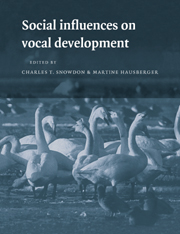Book contents
- Frontmatter
- Contents
- List of contributor
- 1 Introduction
- 2 Social interaction and sensitive phases for song learning: A critical review
- 3 Social interaction and vocal development in birds
- 4 Building a social agenda for the study of bird song
- 5 Field observations, experimental design, and the time and place of learning bird songs
- 6 Vocal learning in wild and domesticated zebra finches: Signature cues for kin recognition or epiphenomena?
- 7 What birds with complex social relationships can tell us about vocal learning: Vocal sharing in avian groups
- 8 Social influences on song acquisition and sharing in the European starling (Sturnus vulgaris)
- 9 Social influences on the acquisition of human-based codes in parrots and nonhuman primates
- 10 Vocal learning in captive bottlenose dolphins: A comparison with humans and nonhuman animals
- 11 Vocal learning in cetaceans
- 12 Social influences on vocal development in New World primates
- 13 Some general features of vocal development in nonhuman primates
- 14 Social influences on vocal learning in human and nonhuman primates
- 15 The resilience of language in humans
- 16 Reciprocal interactions and the development of communication and language between parents and children
- 17 Crafting activities: Building social organization through language in girls' and boys' groups
- Index
16 - Reciprocal interactions and the development of communication and language between parents and children
Published online by Cambridge University Press: 04 August 2010
- Frontmatter
- Contents
- List of contributor
- 1 Introduction
- 2 Social interaction and sensitive phases for song learning: A critical review
- 3 Social interaction and vocal development in birds
- 4 Building a social agenda for the study of bird song
- 5 Field observations, experimental design, and the time and place of learning bird songs
- 6 Vocal learning in wild and domesticated zebra finches: Signature cues for kin recognition or epiphenomena?
- 7 What birds with complex social relationships can tell us about vocal learning: Vocal sharing in avian groups
- 8 Social influences on song acquisition and sharing in the European starling (Sturnus vulgaris)
- 9 Social influences on the acquisition of human-based codes in parrots and nonhuman primates
- 10 Vocal learning in captive bottlenose dolphins: A comparison with humans and nonhuman animals
- 11 Vocal learning in cetaceans
- 12 Social influences on vocal development in New World primates
- 13 Some general features of vocal development in nonhuman primates
- 14 Social influences on vocal learning in human and nonhuman primates
- 15 The resilience of language in humans
- 16 Reciprocal interactions and the development of communication and language between parents and children
- 17 Crafting activities: Building social organization through language in girls' and boys' groups
- Index
Summary
INTRODUCTION
The first studies of language acquisition by the child described mainly the developmental stages of this specific human ability From Piaget (1923) to Brown (1973), authors were interested mostly in the different formal aspects of the acquisition: for example, the age of onset, total amount of language at any age, mean length of utterance, and emergence of grammar. These studies considered the abilities of each child as representative of the general linguistic abilities of the human species at this ontogenetic stage.
More recently, new trends have appeared, where language is studied in a more pragmatic way: it is considered as a means, at each developmental stage, for a child to elicit real communicative interactions. Thus, while admitting that the general stages of language development are alike in any child (Locke & Snow, Chapter 14) such an approach to the development of communication implies integrating various aspects that are usually considered separately by different researchers.
On the one hand, to consider the emerging linguistic skill as part of the larger phenomenon of communication implies integrating the analysis of the linguistic competence of a child at a given stage with that of previous stages, in particular with babbling. It implies also the integration of other communicative behaviors: for example, approaches, emotional addresses, and object exchanges. It can be hypothesized that, when a child is communicating, it is both acquiring the human language and developing its personal communicative style with human beings.
- Type
- Chapter
- Information
- Social Influences on Vocal Development , pp. 312 - 327Publisher: Cambridge University PressPrint publication year: 1997
- 1
- Cited by

